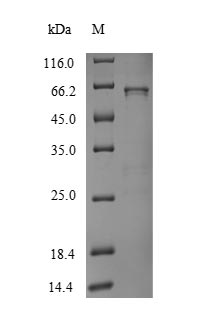Thanks for your inquiry.
CSB-EP366021EEB
1) The product name in the previous catalog is wrong. Please revise product name from "Recombinant Enterobacteria phage T7 Helix-destabilizing protein(2.5)" to
"Recombinant Enterobacteria phage T7 Single-stranded DNA-binding protein gp2.5 (2.5)".
Code: CSB-EP366021EEB
Name: Recombinant Enterobacteria phage T7 Single-stranded DNA-binding protein gp2.5 (2.5)
Expression Region: 1-232aa, Full Length
Tag Info: N-terminal 6xHis-SUMO-tag
Expression Sequence:
MAKKIFTSALGTAEPYAYIAKPDYGNEERGFGNPRGVYKVDLTIPNKDPRCQRMVDEIVKCHEEAYAAAVEEYEANPPAVARGKKPLKPYEGDMPFFDNGDGTTTFKFKCYASFQDKKTKETKHINLVVVDSKGKKMEDVPIIGGGSKLKVKYSLVPYKWNTAVGASVKLQLESVMLVELATFGGGEDDWADEVEENGYVASGSAKASKPRDEESWDEDDEESEEADEDGDF
Uniprot Link: http://www.uniprot.org/uniprot/P03696
2) Code: CSB-EP321793EDY
Name: Recombinant Enterobacteria phage T3 Helix-destabilizing protein (2.5)
Expression Region: 1-232aa, Full Length
Tag Info: N-terminal 10xHis-tagged and C-terminal Myc-tagged
Expression Sequence:
MAGFKKKVYTSGLGTAEPYAYLSKPDYGNEERGFGNPRGVYKVDLTLSNKDPRCQAMVDEIVKTHEEAYAAAVEEFEANPPQVQRGKKPLTPYEGDMPFFDNGDGTTTFKFKCYASFQDKKTKETKHINLVVVDSKGKKIQEVPIIGGGSKLKVKYSLVPYKWNTAVGASVKLQLESVMLVELATFGGGGEDEWADEVEDGGYTASESRQSRDEQEWQEDEHEETPDDDEDF
Uniprot Link: http://www.uniprot.org/uniprot/P20313
Note: CSB-EP321793EDY is a semi-customized protein instead of developed protein, so the price will be relatively higher and the smallest size will be 50ug. CSB-EP321793EDY corresponds to the AA sequence in the previous catalog.
2. CSB-YP366021EEB
The product name in the previous catalog is wrong. Please revise product name from "Recombinant Enterobacteria phage T7 Helix-destabilizing protein(2.5)"to
"Recombinant Enterobacteria phage T7 Single-stranded DNA-binding protein gp2.5 (2.5) ".
Code: CSB-YP366021EEB
Name: Recombinant Enterobacteria phage T7 Helix-destabilizing protein(2.5)
Expression Region: 1-232aa, Full Length
Tag Info: N-terminal 6xHis-tag
Expression Sequence:
MAKKIFTSALGTAEPYAYIAKPDYGNEERGFGNPRGVYKVDLTIPNKDPRCQRMVDEIVKCHEEAYAAAVEEYEANPPAVARGKKPLKPYEGDMPFFDNGDGTTTFKFKCYASFQDKKTKETKHINLVVVDSKGKKMEDVPIIGGGSKLKVKYSLVPYKWNTAVGASVKLQLESVMLVELATFGGGEDDWADEVEENGYVASGSAKASKPRDEESWDEDDEESEEADEDGDF
A. We haven't tested DNA binding activity yet and can't guarantee 100% DNA binding activity.
B. The purification protocol is attached.
C. We could try to remove the tag but can't guarantee 100% success. However, based on our annual analysis data of tag removal, the success rate reaches 75%-86%.
If we succed in removing the tag, we will charge you for protein production cost + tag removal cost.
If we fail in removing the tag, we will send you the tagged protein and will only charge you for protein production cost.






